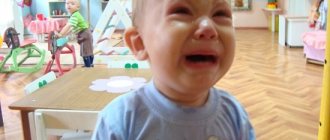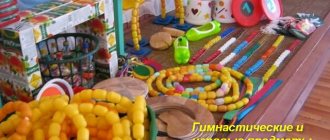The daily routine in kindergarten for all age groups of the kindergarten is based on SanPiN standards, and is designed for a 12-hour stay of a child in a preschool institution. The daily routine in a preschool institution is a strict, down to the minute, sequence of walks, meals, activities, games and daytime rest.
Thanks to such a regimented daily routine in kindergarten, the preschooler develops discipline, a love of order, and the ability to manage his own time, which will facilitate adaptation to school in the future.
In preschool institutions in our country, it is customary to divide children into groups by age. So, the early age group is from 2 to 3 years old; junior group - 3-4 years; middle group - 4-5 years; senior group - 5-6 years; preparatory group 6-7 years old.
However, regardless of the age of the preschooler, the daily routine in kindergarten begins at 7 am, when teachers receive children, and the “working day” in kindergarten begins at 8 am.
Approximate daily routine for a preschooler
7.00-8.30 - Reception of children 8.10 - Exercise 8.30 - Breakfast 9.00-10.00 - Classes 10.30-11.30 - Walk 12.00 - Lunch 12.30-15.00 - Day nap 15.30 - Afternoon snack 16.00-17.00 - Classes 17.00 - Pro party 18:00 - Dinner 19.00 - Care children home
As can be seen from the schedule, according to the recommendations of SanPiN, a kindergarten pupil is provided with four meals a day, with an interval of 4 hours between meals, there are also two walks, one of which is in the afternoon (the time of which may be reduced due to weather conditions), in addition, it is mandatory nap, and of course there is time for activities and games.
It is worth noting that there are slight differences in the daily routine of each group in kindergarten, which take into account the age characteristics of the children.
For example, if the duration of classes in the junior group of a kindergarten is only 10 minutes, then preschoolers of the senior and preparatory groups study for 20-30 minutes, which is close to school classes. The same applies to preparatory moments and getting ready - older children need less time to get dressed for a walk, or wash their hands before lunch.
Next, we will look at several important points from the daily routine in kindergarten in more detail.
Briefly about development standards
The age of 4 years is a time of restlessness, pranks, and outdoor games. The child asks a lot and tries to reason, sometimes revealing “pearls” that make the parents laugh so much. A four-year-old is actively making friends, establishing various social connections and trying to assert himself - for example, by demonstrating interesting toys or physical skills.
If we turn to medicine, then the development standards for 4 years are as follows:
- Speech. The child constructs sentences of 6-8 words, uses prepositions correctly, retells fairy tales, and knows 2-3 verses by heart. He can find an object by description, tell about the events of the day, knows his last name, first name and residential address. Speech arsenal – 1000–3000 words.
- Thinking. The child can easily count to 9, he matches sounds and letters, solves riddles and masters simple puzzles. He can assemble a construction set based on a drawn example, find the differences in the picture, and insert the missing puzzle pieces. The attention span increases to 5 minutes.
- Physical abilities. By the age of 4, coordination, dexterity, and fine motor skills improve. A child is able to string large beads onto a fishing line, draw a continuous line, or shade a simple figure. He can zip up clothes, untie shoelaces, and is good with a fork and spoon.
At 4 years old, a child feels the need to express himself as an individual. Sometimes his behavior leaves much to be desired. The parents’ task is not to scold, but to support and direct the child’s strength in the right direction.
Kindergarten classes
As mentioned above, the duration of classes depends on the age of the child. A lesson in the junior group lasts 10 minutes, 15 minutes in the middle group, 20-30 minutes in the senior and preparatory groups.
In these classes, the preschooler learns a lot of new things, begins to form his horizons, and becomes familiar with the basics of writing and mathematics. If the kindergarten is specialized, with a certain focus, then additional classes may be included in the schedule. Also, the schedule in the middle and senior groups may include additional thematic classes and developmental clubs.
In kindergarten, not only the time of classes is regulated, but also their distribution throughout the day. The schedule is drawn up so that children not only do not become overtired, but also make the most of their activity.
Thus, classes that require increased concentration are carried out in the first half of the day, between 9 and 12 hours, all others - in the afternoon, between 16 and 18 hours. Activities that require perseverance and attention alternate with outdoor games and gymnastic warm-ups.
In addition, the most complex subjects, such as the basics of mathematics and writing, and speech development, are scheduled in the first days of the week, when preschoolers are most alert; for the rest (music classes, drawing, etc.) the second half of the week is usually reserved.
We teach to study
This is where the biggest difficulty awaits parents. Children are used to it and love to play. But learning for them is something incomprehensible in principle, and therefore boring and unnecessary. In a group of peers, children study together, which is an additional incentive. In addition, experienced teachers know how to find an approach to children and interest them in the upcoming work. But how can you explain to your child at home what the point is in learning?
Most of us will start to scare the child with the fact that “ignoramuses, when they grow up, work as janitors or loaders.” To a child, such a prospect seems very distant and vague. And besides the fact that he will devalue the work of a loader or janitor for himself, such suggestions will be of no use.
The second option, and also not the best, is bribery: if you read it, you will receive a toy, sweets, or play on the computer. This approach will only create commodity-money relations between the preschooler and adults. The baby will not be interested in the result of his work. It will be important for him to quickly finish what is preventing him from having fun and get the desired reward.
How can you help your child accept the need for classes?
- Appreciate all your child’s achievements: both existing and upcoming ones. Teach it to teach, and not to satisfy your unfulfilled ambitions.
- Don’t cram as much knowledge into it as no one knows everything. First of all, take into account what is interesting to the child himself, comparing with the requirements for readiness for school.
- Do not compare your own child with others who are more successful - this will lower the child’s self-esteem and discourage the desire to learn. Compare with how he himself is progressing.
- You cannot buy the efforts of a preschooler with some benefits, just as you cannot force him to study as a punishment for wrongdoing.
- You cannot punish for mistakes or inability. Parents are helpers, mentors and advisers.
- Always praise your child for any successes, support him, show your pride in his successes and faith in his strength.
- Difficult tasks cannot be excluded. They are most useful for the development of the baby. Just show him that you are always ready to help.
- Stick to the established time of classes, observe age standards for their number per day and duration.
- Diversify your lessons with fun physical education breaks so that your child doesn’t sit too long and get tired.
The daily routine of a preschooler is aimed, first of all, at his development and preparation for learning. Therefore, it is so important to draw it up correctly and strictly adhere to it. This habit will help the child throughout his life. It will make him more confident, organized and productive.
Meals
The main meals in kindergarten are breakfast, lunch, afternoon snack and dinner, if the child is in kindergarten until 19:00.
In all preschool institutions, regardless of their focus, meals are scheduled at approximately the same time: at 8.00-8. 30 breakfast, 12.00-13.00 lunch, 15.00-15.30 afternoon tea, 18.00 dinner.
In the daily routine according to SanPiN, each meal is preceded by preparation: children wash their hands and sit down at tables. The time for this preparation is also regulated and reduced depending on the age group.
Recommendations for organizing the day
Organizing a four-year-old's day is not as easy as it seems at first glance. At this age, children tend to contradict everything. To make innovations painless, it is important to make the transition smooth. At the same time, the parent must clearly understand why the daily routine is needed and not deviate from what was planned.
Main rules:
- Do not force a child. Just captivate by offering similar alternative options.
- Be systematic. Do not deviate from the schedule even for a day, except for really compelling reasons (travel, serious illness).
- Stay calm and be patient. A parent's irritation and nervousness is a sign for the child that something unpleasant is waiting for him.
Dream
For a 4-year-old child, daytime naps are still mandatory. According to doctors, children need rest until they are 7 years old. Continuous wakefulness from morning until late evening overloads the nervous system, depletes physical strength, and affects the development and health of the baby. As night approaches, the child becomes whiny, capricious, can throw tantrums for no reason, and often wake up at night.
Standards of official medicine for 4 years:
- total amount of sleep – 12-13 hours;
- daytime sleep – 2-2.5 hours;
- The optimal night period is from 21:00 to 08:00, daytime - from 12:00 to 15:00.
An exception to the rule is cases when a child tolerates a lack of sleep during the day without pain. However, the amendment only applies to children over 5 years of age.
If the child categorically resists daytime sleep, it is worth offering an alternative - to rest lying down for 1-2 hours. You can turn on calm music, make the room twilight by closing the curtains. Read a fairy tale. Most likely, after 6-7 such sessions, the baby will begin to fall asleep.
Food
A 4 year old child is very active and spends a lot of energy playing. The quality of nutrition determines the baby’s endurance, ability to learn, and growth. It is best if the child eats by the hour. Eating meals at the same time promotes the production of gastric juice. As a result, appetite increases, food is well digested and absorbed.
Pediatricians give the following recommendations for the nutrition of a 4-year-old child.
- Four meals a day: breakfast, lunch, afternoon snack, dinner. A second breakfast is added based on the needs of a particular child.
- Single serving – 500 grams with drink.
- The daily amount of calories is 1700. Of these, 20-25% should be for breakfast and dinner, 40-45% for lunch, and the rest for an afternoon snack.
- The volume of liquid consumed per day is 1 liter.
- The daily diet must include 100-200 g of lean meat, 250 g of fruits and vegetables, 300 g of porridge, 15-30 g of butter or vegetable oil.
- Every week you need to eat fish 2 times (200 g each), a chicken egg 4 times, cottage cheese 3-4 times (120 g each).
- Variety of products: at least 25 varieties per week (various cereals, berries, vegetables, herbs, yoghurts, sour cream, cheeses, poultry, beef, lean pork, seafood).
- From the age of 4, it is necessary to introduce onions and garlic into the diet: 1 clove (feather) 2-3 times a week.
- A minimum of sweets, smoked foods, fried foods. Snacks – afternoon snack, second breakfast. Sweet dishes are served for dessert, after the main meal.
Surely the child already has his own food preferences and refuses some healthy foods. There is no need to force them to eat. It's better to resort to cunning. For example, treat your baby's friend to his least favorite food. Children at this age tend to imitate their peers.
Walks and quiet time
These important components of the daycare routine are also age-appropriate.
Children from the early age group go for a walk earlier than others, at 9.00-9.30. The quiet hour has also been increased - babies sleep on average from 12.30 to 15.00.
Children from the senior group and the preparatory group go to a quiet hour at 13.00; their sleep lasts an average of 1.5 hours. They also have a shorter time to prepare for a walk - children at this age can already independently and quickly change clothes for playing in the fresh air.
However, regardless of age, quiet time in kindergartens ends at 15.00. After afternoon tea, the younger groups have a general education lesson; students from the middle and older groups are engaged in games or independent activities.
During the second walk, the children are gradually picked up by their parents. In winter, due to the fact that it gets dark quite early, the time for the second walk is reduced, and children are taken directly from kindergarten. Also, the walk may be shortened due to weather conditions: for example, frost or strong wind.
Home mode
What should you do if, for some reason, your child does not and will not attend kindergarten? Sticking to the same regime is a definite thing. True, with some nuances. The first of them is that the baby can be allowed to wake up a little later (since there will be no time needed to travel to the kindergarten). Secondly, you can also put the baby to bed later.
Another subtlety is that parents will have to organize educational activities for their child themselves. To do this, it is advisable to familiarize yourself with the requirements for preparing a child in the school that the child will attend in the future, and try to prepare the child in accordance with them. Of course, you can also attract specialists to help (for example, enroll your child in an early development group or with a teacher who will take on the role of a kind of tutor). But if you have confidence in your own abilities, then it is better if the parents teach the preschooler. This way they will have the opportunity to once again (which is not at all superfluous!) demonstrate to him their love, interest in his development and pride in his first achievements.
You will have to do the same things as in the garden: teach writing, reading, drawing, sculpting, dancing, teaching basic mathematical concepts, developing speech, studying nature, playing, developing the child physically (independently or in a sports section), and be sure to accustom him to work. Among other things, mothers are entirely responsible for their child’s diet.
Games, joint and independent activities
Games and shared activities are very important for children. They teach children to communicate, develop creative thinking and imagination. During joint classes, a group of children completes tasks proposed by the teacher, thus preschoolers learn to work in a team and develop communication skills.
A total of three hours are allotted for independent games and activities, which allows the child to devote time to his own interests. Children play during the remaining time in such a tight schedule: before morning exercises, before and after classes, during walks.
- share with your friends!








